
Here I am taking a walk down to the creek.

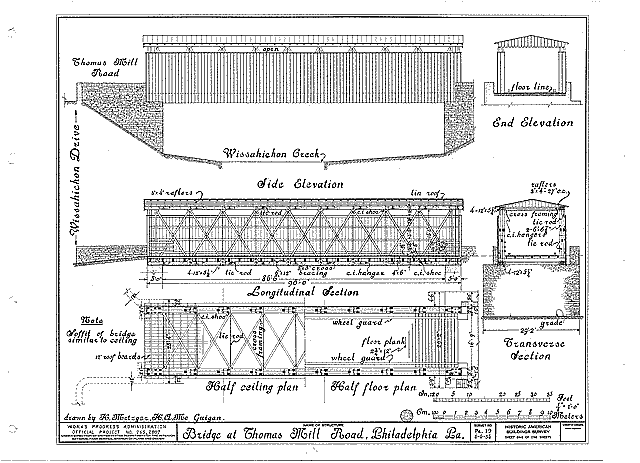
CATFISH AND WAFFLES - An annotated encyclopedia of places, people and
things associated with the Wissahickon Creek and Surrounding Environs
Catfish - was a favorite food, along with waffles, at the many roadhouses
that were scattered throughout the Wissahickon Valley in the 1700 and 1800's.
The meal did not just consist of catfish and waffles. In general, it usually
included catfish, a steak, chicken, waffles and a dessert. According
to one author, the meal is best topped off by a light beer, not wine or
water.
Chestnut Hill - This now affluent community borders the Wissahickon Creek on the north side and adjoins Montgomery County on west and Mount Airy on the East.
Germantown - This community borders the north side of the Wissahickon Creek and adjoins Mt. Airy on the West and North Philadelphia on the East.
Finger Span Bridge - Located about one half mile south of Livezey House, the Finger Span Bridge is a modern (1987??) steel bridge, built with a joint to resemble a bent finger. It weighs over 18,000 pounds and is essentially an enclosed iron grate spanning a deep crevice. The Fingerspan Bridge was installed using a helicopter and dropped into place.
Glen Fern - See Livezey House
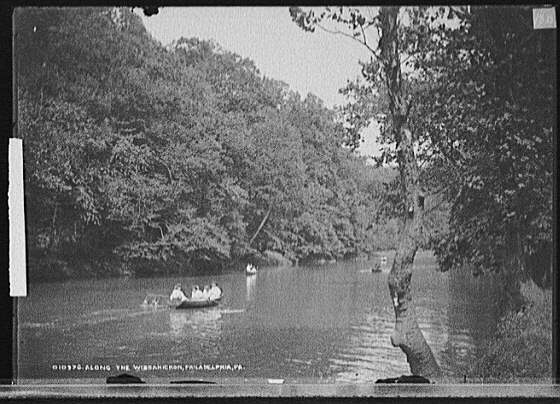
Gorgas, Joseph - has a lane named after him in Roxborough. Gorgas led a group of Seventh Day Adventists who lived with him in the Monastery located on the opposite side of the creek from Monastery Avenue in Roxborough,. Today the Monastery is used as a stable.
Holgate, Matthew - established a fulling mill in 1698.
Howell, Daniel - owned one of the grist mills built on the creek about 1710.
Indian Rock - the council stone of the Leni Lenape, forms part of the bluff where today the statue of an Indian, (usually referred to as Tedyuscung) is placed today.
Kelpius, John - Born in 1673, Kelpius was a German mystic who came to
the area when he was only 23. He lived in Germantown for some time and
then moved to the area of what is today Hermit Lane, between Wissahickon
and East Falls. Her Kelpius and his followers built a log cabin.
With Kelpius, Dr. Christopher Witt developed "The Society of the Woman
of the Wilderness." This group utilized symbolism from Revlations,
astronomy, horoscopes, magic and practiced divining and their own brand
of spiritual medicine. They became known as a group of strange eccentric
hermits.
Around 1890 Samuel Pennypacker bought a lot of books at a public
sale and discovered a hymnal that belonged to the group. One stanza from
a hymn entitled "The Mourning Song of Complaint of the Solitary Turtle
Dove in the place of its trial" goes as follows:
"My Dovelet, where art thou?
Sweet Angel, why part thou?
My heart is so painful
Oh, be not distainful.
My Dovelet, where art thou?
Come Angel, consoling my heart now."
Kelpius died when he was only 35, and most of his followers moved west
to Ephrata, Pa, or back to Germantown.
Livezey House- Glen Fern is the name given to the former Livezey house
still standing today at the bottom of Allen's Lane.
Mills - at one time the Wissahickon Creek supported over 50 mills of various types. Grist mills, fulling mills and paper mills were most common. See entries under Rittenhouse, Holgate, and Howell, who were owners and builders of some of these mills.. The function of a grist mill is to grind corn and other foodstuffs into usuable form, while a fulling mill removes animal grease from the sheared wool of sheep. There was also a nail mill, at least one fabric mill and a cotton wadding mill. From the late 1690's until the early 1800's the mills along the Wissahickon provided a source of income for many of the families in the area. Whole communities formed around the central core of the community which was the mill. Rittenhouse Town is the sole surviving community of what had been a bustling industrial area.
Mom Rinker's Rock - is reputed to be the spot where Mom Rinker
sat as she spied for the colonists during the Revolutionary war. She is
said to have sent information down to the waiting revolutionary soldiers
in her ball of yarn.
Monastery - This building, built about 1750, was used by Joseph Gorgas
and his followers as a retreat from the problems of everyday life.

Pastorious, Francis Daniel - the founder of Germantown, who came to
the area about 1683. Today Pastorius Park is named after him. He was given
the land by William Penn for himself and his "German Company."
Penn, William - Born in England, Penn's father was a friend of the King. Penn was given the land in the colonies by the King as part of payment for a debt the King owed his father. As we know, William Penn has the state named after him and made tremendous contributions to the future United States. Penn then came to America and purchased the land from the Leni Lenape indians, even though he probably did not need to do this.
Penn's final tribute to the Wissahickon area was an amount of
money (100,000 pounds) which he left to the city in his will. The purpose
of which is explained in this excerpt from his will:
"Having considered the covering of a ground plot with buildings
and pavements, which carry off most of the rain, and prevent its soaking
into the earth and renewing and pruifying the springs, whence the water
of the wells must gradually grow worse, and in time be unfit for use...
I recommend that at the end of the first hundred years, if not done before,
the city employ a part of the 100,000 pounds sterling in bringing, by pipes,
the water of Wissahickon Creek into town, so as to supply the inhabitants."
Poe, Edgar Allen - During the time that Poe lived in Philadelphia he visited the Wissachickon Creek at least once and wrote a short essay that was published in the ECHO. Read this piece, also called The Elk, here.
Rinker, Mom - see Mom Rinker's Rock.
Rittenhouse Town - Today, this small community of buildings is what has survived from the Rittenhouse paper mill and its ancillary buildings. It has been developed and restored by a group and today offers tours and information sessions at the site. Rittenhouse Town is located at Lincoln Drive and Rittenhouse Street.
Rittenhouse, William - Came to the colonies from Germany and is known
as the builder of the first paper mill in the colonies in the late
1680's. For a time this was the only paper mill in the colonies and
it is reputed that this mill supplied much of the paper for Benjamin Franklin.
Rittenhouse, David. Was an enthusiastic astronomer, businessman, scientist
and patriot. . Rittenhouse tried farming, built clocks and then studied
the skies. Later in life Rittenhouse was State Treasurer, Director
of the Mint and was the President of the American Philosophical Society.
Rittenhouse Mill - This mill was first a grist mill and then began making
paper. It was the first paper mill in the colonies. See Rittenhouse,
David.
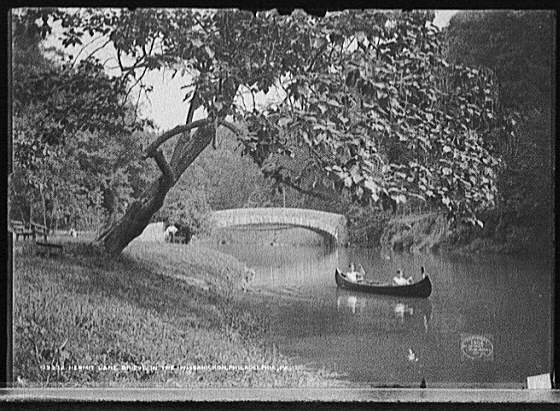
Robeson's Mill - This land and mill were then sold to John Townsend in 1686 and to Robert Turner in 1691.
Roxborough - Supposedly the name for this community was derived from John Kelpius discovering foxes digging in the basement of his log cabin. Because a great deal of rocks were in the walls, he named the area Rocksborrow. Today Roxborough forms the eastern boundary of the Wissahickon Valley, along with Andorra, Wissahickon and East Falls.
Tedyuscung - the famous Indian who was immortalized in a statue still standing just off Forbidden Drive and Rex Avenue overlooking the valley below. Originally made of wood, the statue was replaced by a concrete indian statue donated by Mr. & Mrs. Henry.
Valley Green Inn - More later on the Inn, but try this link for a picture and original plans of the building. Plans of the Inn (housed at the Library of Congress).
Waffles - see Catfish.
Walnut Lane Bridge - Towering over Lincoln Drive and the Wissahickon
Creek, the Walnut Lane Bridge was, at the time it was built, the longest
cement bridge in the world.
Whittier, John Greenleaf - American poet..
wrote the poem The Pennsylvania Pilgrim,with references to the Wissahickon.
It's long... mentions Pastorius, Kelpius, other German settlers,
Krisheim, (today spelled with a C), the Delaware and of course
The Wissahickon.
Look here... The Pennsylvania Pilgrim
Wissahiccon- is how Edgar Allen Poe spelled the name of the creek in his essay regarding the tranquility of the creek and his probable dream about the Elk. See the Appendix for a complete copy of this essay.
Wissahickon - the name of the creek and the community of Wissahickon
derive from either the Leni Lenape words for yellow colored stream -Wisaucksickan,
or from Wisamickan, the Indian word for Catfish Creek. A great deal of
industrial development took place along the Wissahickon Valley in
the 1700Æs and mid 1800Æs, most in the tremendous building
boom of mills. A combination of romantic movements, nature lovers and some
visits and reports from at least two famous people to the Valley led to
a revolt against the industrialization. In 1870, the Fairmount Park Commission
started an aggressive campaign to move the park area back into a natural
area. The Park commission purchased most of the mills and almost immediately
tore them down. Franny Kemple and Edgar Allen Poe both wrote of the
beauty of the park. See separate entries for these two people.
Wissahickon Creek - The Wissahickon Creek originates in Montgomery county
as a number of springs, and flows into the Schuykill River and then into
the Delaware.
Sources:
Conwill, Joseph D. The Wissahickon Valley to a Wilderness Returned. Pennsylvania Department of State Web Page. <http://www.dep.state.pa.us/dep/PA_env-Her/wildrnss.htm>
T. A. Daly The Wissahickon . Garden Club of Philadelphia, 1922
Faris, John T. Old Trails and Roads in Pennsylvania. J. B. Lippincott, 1927
Miles, Joseph and William H. Cooper, A Historical Sketch of Roxborough,
Manayunk Wissahickon. George Fein & Company
Pictures from the Library of Congress MORE LINKS TO PHILADELPHIA HISTORY
hits since August 29, 1999
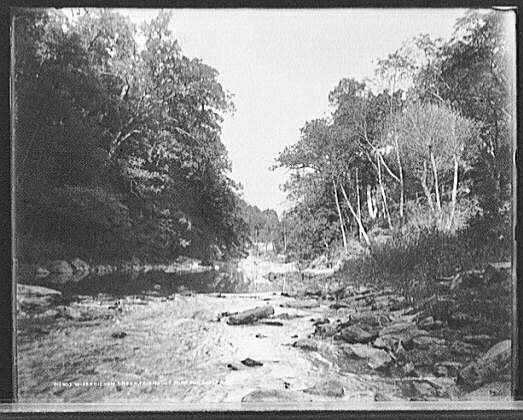
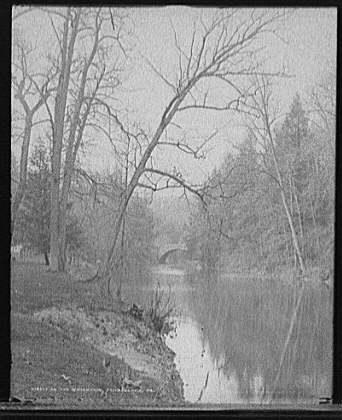

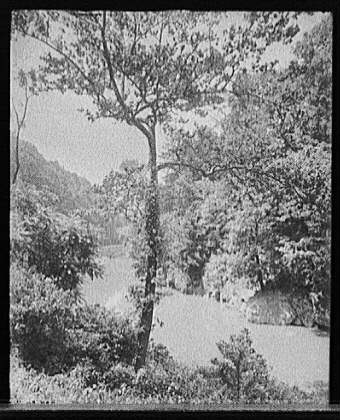
Pictures I have taken of the covered bridge...
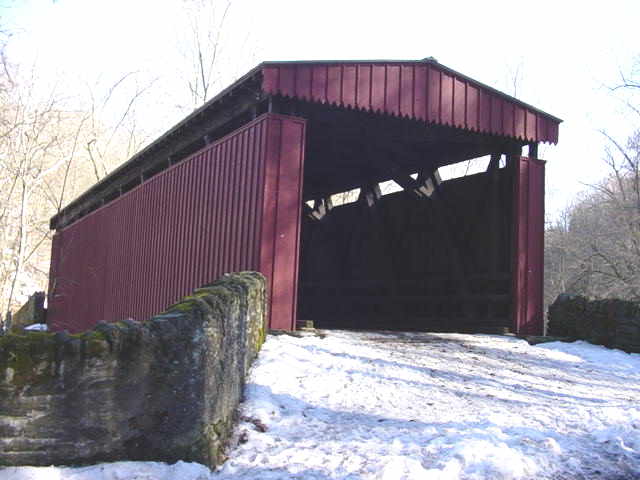

And finally some music written about the creek.... most curious.

More Pictures of the Creek
The Church of the Brethren visit the Wissahickon -
Visit them here
Philadelphia Parks... Wissahickon Valley Links
The Wissahickon Restoration Volunteer's - a group that
works to improve the park.
More on the Wissahickon around Blue Bell Hill and Rittenhousetown...
![]()